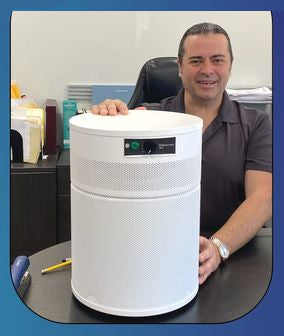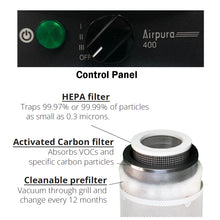
Info: Home or Office Air Purifiers, In a Choice of Case Colours & Filter Types
New! While some companies gravitate to fancy exterior designs, complicated wi-fi enabled controls, or questionable ozone-generating technologies to try to keep their units looking small and elegant or to reduce the cost of their individual filters (but not necessarily the frequency of their replacement!), Airpura knows the only way for a machine to truly clean the indoor air is to actually capture and trap its pollutants in an appropriate filter media – permanently, and without adding pollutants of its own.
Info: Home or Office Air Purifiers, In a Choice of Case Colours & Filter Types
New! While some companies gravitate to fancy exterior designs, complicated wi-fi enabled controls, or questionable ozone-generating technologies to try to keep their units looking small and elegant or to reduce the cost of their individual filters (but not necessarily the frequency of their replacement!), Airpura knows the only way for a machine to truly clean the indoor air is to actually capture and trap its pollutants in an appropriate filter media – permanently, and without adding pollutants of its own.
Product Notes:
S&H included to most locations in Canada.
Although they're well suited to large spaces, some of Airpura's previous models may seem like 'overkill' for the average home or apartment user, not only with the sheer size of the machines, but even the filters (some weigh 26 pounds!). This new 400 Series rectifies that with these first four models, which are about one third smaller and less expensive than their 600 or 700 series counterparts.
Airpura has been producing professional grade air purifiers for 20 years, now, which feature a utilitarian design with the same barrel-shaped base (albeit in a choice of colours) for all their free-standing units which can be configured in different ways with a variety of filters or an upgraded motor to suit the customers' needs, and a decided absence of fancy bells and whistles for the controls – focusing instead on the essentials to keep the air clean.
Those essentials – which all still apply to these new models – include Zero ozone emissions, and:
* The selection and placement of materials to avoid off-gassing from the machine itself, such as an all-metal (rather than plastic) base, made from powder coat steel, with thousands of perforations for the air intake all the way around; a pressure sealed filter chamber, using a large felt (rather than rubber) gasket; an absence of silicone, adhesives or bonding agents; and a separate chamber for the electrical parts to contain any potential off gassing from the capacitors, condensers or switches.
* True HEPA filters, with 40 square feet of surface area, with 10 pleats per inch, warm rolled (to prevent cracking) with separators/spacers (to ensure every fold filters).
* A variable speed (with 3 settings) fan motor that's situated away the clean air flow, with a backward curved motorized impeller to eliminate vibrations and reduce noise.
* A choice of carbon filter types or housings or other technologies for removing airborne gases, chemicals, odours, and bacteria and viruses.
But until now, Airpura's free-standing (they also make Central units to integrate with your furnace or HVAC system) systems have perhaps been generally regarded as a bit too large and overpriced for most regular home or apartment dwellers' needs, with those units being nearly two feet tall ('thigh high', for many adults) and 15" in diameter (large pizza size), weighing between 36 and 50 pounds or more, and being rated for indoor spaces as large as 2,000 square feet (which far exceeds most actual living rooms or bedrooms, which tend to be no more than 400 sq. ft.). 
So, by popular demand, Airpura has launched a whole new line of smaller free-standing units that are about two-thirds that size: standing 15-1/2 inches tall (on removable plastic feet, rather than casters, so they can be placed on desks or other surfaces, if desired), with a 12" (medium pizza-sized) diameter, and weighing some 23 pounds (10.4 kg, including the filters), and being rated for indoor spaces up to 1,000 sq. ft. (for 2 air exchanges per hour, in rooms with 8 foot ceilings).
As before, they share the same external housing, in a choice of colours, and these first ones all have the same simplified control panel with a large power light indicator and a knob to control the fan speed (although future 400 series models may also be equipped with UV lights and have an additional switch for them), and they have a five year warranty for residential users (apart from the filters). They're all designed to operate on standard 110V-120V voltage, of course, and their power consumption and noise levels range between 18 and 77 Watts and 32 to 52 db, respectively, depending on which of the three fan speeds is selected.
Where these four models differ between themselves is in:
1) Which type of medical grade true HEPA filter they have, with:
- the models ending in '00' being outfitted with their regular H13 type, which has a removal rate of 99.97% of airborne particles up to 3 microns in size - the industry standard; and,
- the two '-14' models having Airpura's new Super HEPA filters (an H14 type), which are denser (and thus do restrict the air flow by about 11%), have a superior 99.99% removal rate, which would probably be better at capturing airborne bacteria and viruses.
2) Which type of filter they're equipped with to remove chemicals, gases, odours, and volatile organic compounds (VOCs) which can be emitted by things like new furniture or wall paneling, fresh paints or primers, or tobacco or other types of smoke. While all four are endowed with a one-inch thick bed of 8 pounds of highly porous activated carbon to attract and hold organic chemicals (which is probably at least 7 pounds more than some companies provide in their dual purpose filters!),
- in the two R models geared more for everyday use, that has been produced solely from (superheated) Coconut Shells, as is customary for this type of application; but,
- in the two V models designed for settings with heavier VOC loads, such as workshops, construction sites, or places in the path of wildfire smoke or refineries emissions, these filters have been upgraded with ones where the coconut shell carbon has been infused with Potassium Iodide, in order to accelerate the molecular binding between those noxious chemical compounds to remove them more quickly. The potassium iodide assists in the desulphurization of acrid exhaust gases and the removal of the acidic contaminants like hydrogen sulfide and mercaptans associated with their "rotten eggs" smell, and of the irritating hydrogen chloride gas that can be emitted by swimming pool disinfectants or varnish fumes, or by burning or decomposing PVCs, among other things.
It should be noted there are three types of consumables for these machines. Their placement, replacement frequency, and current manufacturer's retails (in Canadian dollars) are as follows:
1) The prefilter sheet, which wraps around the other two, and can be vacuumed through the holes in the base periodically while still in place to remove some of the dust, should last about a year. They retail for just $20 each (they will be sold in packets of 2, for $39.98).
2) The activated charcoal filter, the largest one, which goes in the middle; it should last a full two years. Their replacement will cost $219.98 for the R models or 279.98 for the V.
3) The true HEPA filter, which gets placed in the centre, inside the charcoal filter. It can last 3 years, even with continuous use (compared to just 6 months to 1 year for many other brands). Replacing it will cost $179.98, for the regular version, or an estimated* $209.98 for the SuperHEPA version (*based on the differential between their larger-size versions).
There will also be some discounts if those filters are bought together in bundles.
Technical Specifications for the Variations Between these Models
| Model | R400 | R414 | R700 | R414 |
|---|---|---|---|---|
| Fan Speed | 395 CFM (Free Flow) | 353 CFM (Free Flow) | 395 CFM (Free Flow) | 353 CFM (Free Flow) |
| Prefilter (355 sq. inches x 1" deep) | Poly Prefilter, Vacuumable, Replace after 12 months | Poly Prefilter, Vacuumable, Replace after 12 months | Poly Prefilter, Vacuumable, Replace after 12 months | Poly Prefilter, Vacuumable, Replace after 12 months |
| Chemical gas & odor filter (1" Carbon Bed) |
8-lbs, Activated Carbon Filter (100% Coconut Shell), Replace: 2 years | 8-lbs, Activated Carbon Filter (100% Coconut Shell), Replace: 2 years | 8 lbs Activated & Enhanced Carbon Filter (Potassium Iodide, Coconut Shell) Replace: 2 years | 8 lbs Activated & Enhanced Carbon Filter (Potassium Iodide, Coconut Shell) Replace: 2 years |
| HEPA Filter Type & System Efficiency | H13 HEPA Filter: 99.97% of airborne particles ≥ 0.3 microns; Replace: 3 years | H14 Super HEPA Filter: 99.99% Efficient at 0.3 microns, Replace: 3 years | H13 HEPA Filter: 99.97% of airborne particles ≥ 0.3 microns; Replace: 3 years | H14 Super HEPA Filter: 99.99% Efficient at 0.3 microns, Replace: 3 years |
You can download the Airpura R400 User Manual and Specifications [PDF, 770 kb] and the Airpura V400 User Manual and Specifications here [PDF, 615 kb].
Product Options:







